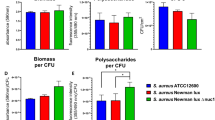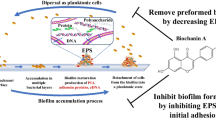Abstract
Biofilm genesis by Pseudomonas and Staphylococcus sp is associated with biofouling in natural settings. D-Tryptophan (D-Trp) inhibits bacterial biofilms and have been proposed for biofouling control applications. In this study, D-Trp significantly inhibited Pseudomonas mendocina and Staphylococcus aureus cell attachment (biofilm formation) rates on polystyrene 96-well microtiter plates in comparison with L-Tryptophan (L-Trp) and mixtures of D-/L-Tryptophan (D-/L-Trp). The inhibitory effect was greater on P. mendocina, where the rate of cell adherence was declined to 8.7 × 105 cells/h from 8.0 × 106 cells/h (control) in P. mendocina. In S. aureus it was declined to 4.2 × 107 cells/h from 9.2 × 107 cells/h (control) at 1 mM concentration. It hindered the intracellular communication and adherence in both the strains, as confirmed by SEM and real time PCR analysis. Addition of D-Trp to preformed biofilms also caused partial disassembly. Intra and interbacterial aggregation were decreased subsequently upon treatment with D-Trp. It repressed the genes involved in cell–cell communication, which could be responsible for the diminished biofilm formation of the selected strains. Hence D-Tryptophan has proved to be an effective strategy to control biofilm and may support in the development of surface coating technologies.





Similar content being viewed by others
References
Barraud ND, Schleheck J, Klebensberger JS, Webb D, Hassett J. Rice SA and Kjelleberg S 2009 Nitric oxide signaling in Pseudomonas aeruginosa biofilms mediates phosphodiesterase activity, decreased cyclic di-GMP levels, and enhanced dispersal. J. Bacteriol. 191 7333–7342
Bernardeau M, Gueguen M, Smith DGE, Corona-Barrera E and Vernoux JP 2009 In vitro antagonistic activities of Lactobacillus spp against Brachyspira hyodysenteriae and Brachyspira pilosicoli. Vet. Microbiol. 13 184–190
Brandenburg KS, Rodriguez KJ, McAnulty JF, Murphy CJ, Abbott NL, Schurr MJ and Czuprynski CJ 2013 Tryptophan inhibits biofilm formation by Pseudomonas aeruginosa. Antimicrob. Agents Chemother. 57 1921–1925
Bremer PJ, Fillery S and Mcquillan AJ 2006 Laboratory scale clean-in-place (CIP) studies on the effectiveness of different caustic and acid wash steps on the removal of dairy biofilms. Int. J. Food. Microbiol. 106 254–262
Busscher HJ, Norde W, Sharma PK and Van der Mei HC 2010 Interfacial re-arrangement in initial microbial adhesion to surfaces. Curr. Opin. Colloid Interface Sci. 15 510–517
Choi SC, Zhang C, Moon S and Oh YS 2014 Inhibitory effects of 4-hydroxy-2,5-dimethyl-3(2H)-furanone (HDMF) on acyl-homoserine lactone-mediated virulence factor production and biofilm formation in Pseudomonas aeruginosa PAO1. J. Microbiol. 52 734–742
Condell O, Iversen C, Power K and Fanning S 2012 Human safety and environmental concerns associated with the use of biocides. Antimicrob. Polym. 1 527
Flemming HC and Wingender J 2010 The biofilm matrix. Nat. Rev. Microbiol. 8 623–633
Ferreira CL, Grześkowiak L, Collado M and Salminen S 2011 In vitro evaluation of Lactobacillus gasseri strains of infant origin on adhesion and aggregation of specific pathogens. J. Food Prot. 74 1482–1487
Ghosh S, Qureshi A and Purohit HJ 2017a Enhanced expression of catechol 1,2 dioxygenase gene in biofilm forming Pseudomonas mendocina EGD-AQ5 under increasing benzoate stress. Int. Biodeterior. Biodegrad. 118 57–65
Ghosh S, Qureshi A and Purohit HJ 2017b Biofilm microenvironments: modeling approach; in Purohit H, Kalia V, Vaidya A, Khardenavis A. (eds) Optimization and Applicability of Bioprocesses (Springer, Singapore) pp 305–322
Hochbaum AI, Kolodkin-Gal I, Foulston L, Kolter R, Aizenberg J and Losick R 2011 Inhibitory effects of D-amino acids on Staphylococcus aureus biofilm development. J. Bacteriol. 193 5616–5622
Husain FM, Ahmad I, Asif M and Tahseen Q 2013 Influence of clove oil on certain quorum-sensing-regulated functions and biofilm of Pseudomonas aeruginosa and Aeromonas hydrophila. J. Biosci. 38 835–844
Kolodkin-Gal I, Romero D, Cao S, Clardy J, Kolter R and Losick R 2010 D-amino acids trigger biofilm disassembly. Science 328 627–629
Kim SM, Park JH, Lee HS, Kim WB, Ryu JM, Han HJ and Choi SH 2013 LuxR homologue SmcR is essential for Vibrio vulnificus pathogenesis and biofilm detachment, and its expression is induced by host cells. Infect. Immun. 81 3721–3730
Lam H, Dong-Chan O, Cava F, Constantin NT, Clardy J, Miguel A and Waldor MK 2009 D-amino acids govern stationary phase. Science 325 1552–1555
Ledder RG, Timperley AS, Friswell MK, Macfarlane S and McBai AJ 2008 Coaggregation between and among human intestinal and oral bacteria. FEMS Microbiol. Ecol. 66 630–636
Lee JH, Park JH, Cho HS, Joo SW, Cho MH, Lee J 2013 Antibiofilm activities of quercetin and tannic acid against Staphylococcus aureus. Biofouling 29 491–499
Lee SHI, Cappato LP, Corassin CH, Cruz AG and Oliveira CAF 2016 Effect of peracetic acid on biofilms formed by Staphylococcus aureus and Listeria monocytogenes isolated from dairy plants. J. Dairy Sci. 99 2384–2390
Leiman SA, May JM, Lebar MD, Kahne D, Kolter R and Losick R 2013 D-Amino acids indirectly inhibit biofilm formation in Bacillus subtilis by interfering with protein synthesis. J. Bacteriol. 195 5391–5395
Li H, Ye Y, Ling N, Wu Q and Zhang J 2015 Inhibitory effects of D-Tryptophan on biofilm development by the foodborne Cronobacter sakazakii. Int. Dairy J. 49 125–129
Lupoli TJ, Tsukamoto H, Doud EH, Wang TS, Walker S and Kahne D 2011 Transpeptidase-mediated incorporation of D-amino acids into bacterial peptidoglycan. J. Am. Chem. Soc. 133 10748–10751
O’Gara JP 2007 ica and beyond: biofilm mechanisms and regulation in Staphylococcus epidermidis and Staphylococcus aureus. FEMS Microbiol. Lett. 270 179–188
Pal S, Qureshi A and Purohit, HJ 2016 Antibiofilm activity of biomolecules: gene expression study of bacterial isolates from brackish and fresh water biofouled membranes. Biologia 71 239–246
Pal S, Qureshi A and Purohit, HJ 2018 Intercepting signalling mechanism to control environmental biofouling. 3 Biotech 8 364
Qureshi A, Pal S, Ghosh S, Kapley A and Purohit HJ 2015 Antifouling biomaterials. IJRAMR 2 677–684
Ramon-Peréz M., Diaz-Cedillo F, Ibarra JA, Torales-Cardeña A, Rodriguez-Martinez S, Jan-Roblero J, Cancino-Diaz ME and Cancino-Diaz JC 2014 D-Amino acids inhibit biofilm formation in Staphylococcus epidermidis strains from ocular infections. J. Med. Microbiol. 63 1369–1376
Rapsinski GJ, Makadia J, Bhanot N and Min Z 2016 Pseudomonas mendocina native valve infective endocarditis: a case report. J. Med. Case Rep. 10 275
Rickard AH, Gilbert P, High NJ, Kolenbrander PE and Handley PS 2003 Bacterial coaggregation: an integral process in the development of multispecies biofilms. Trends Microbiol. 11 94–100
Rickard AH, Campagna SR and Kolenbrander PE 2008 Autoinducer-2 is produced in saliva-fed flow conditions relevant to natural oral biofilms. J. Appl. Microbiol. 105 2096–2103
Rumbo C, Vallejo JA, Cabral MP, Martínez-Guitián M, Pérez A, Beceiro A and Bou G 2016 Assessment of antivirulence activity of several D-amino acids against Acinetobacter baumannii and Pseudomonas aeruginosa. J. Antimicrob. Chemother. 71 3473–3481
Ryu EJ, Sim J, Sim J and Choi BK 2016 D-Galactose as an autoinducer 2 inhibitor to control the biofilm formation of periodontopathogens. J. Microbiol. 54 632–637
Sanchez CJ, Akers KS, Romano DR, Woodbury RL, Hardy SK, Murray CK and Wenke JC 2014 D-amino acids enhance the activity of antimicrobials against biofilms of clinical wound isolates of Staphylococcus aureus and Pseudomonas aeruginosa. Antimicrob. Agents Chemother. 58 4353–4361
Schmittgen TD and Livak KJ 2008 Analyzing real-time PCR data by the comparative Ct method. Nat. Protoc. 3 1101–1108
Schmeisser C, Stöckigt C, Raasch C, Wingender J, Timmis KN, Wenderoth DF, Flemming HC, Liesegang H, Schmitz RA, Jaeger KE and Streit WR 2003 Metagenome survey of biofilms in drinking-water networks. Appl. Environ. Microbiol. 69 7298–7309
Shah AD and Mitch WA 2012 Halonitroalkanes, halonitriles, haloamides, and N-nitrosamines: a critical review of nitrogenous disinfection byproduct formation pathways. Environ. Sci. Technol. 46 119–131
Simoes L, Simoes M and Vieira MJ 2008 Intergenic coaggregation among drinking water bacteria: Evidence for a role of Acinetobacter calcoaceticus as a bridging bacterium. Appl. Environ. Microbiol. 74 1259–1263
September SM, Els FA, Venter SN and Brozel VS 2007 Prevalence of bacterial pathogens in biofilms of drinking water distribution systems. J. Water Health 5 219–227
Stepanovic S, Djukić N, Opavski N and Djukić S 2003 Significance of inoculum size in biofilm formation by Staphylococci. Microbiologica 26 129–132
Venturi V 2006 Regulation of quorum sensing in Pseudomonas. FEMS Microbiol. Rev. 30 274–291
Waines PL, Moate R, Moody AJ, Allen M and Bradley G 2011 The effect of material choice on biofilm formation in a model warm water distribution system. Biofouling 27 1161–1174
Wang H, Hu C, Hu X, Yang M and Qu J 2012 Effects of disinfectant and biofilm on the corrosion of cast iron pipes in a reclaimed water distribution system. Water Res. 46 1070–1078
Wang J, Yu B, Tian D and Ni M 2013 Rhamnolipid but not motility is associated with the initiation of biofilm seeding dispersal of Pseudomonas aeruginosa strain PA17. J. Biosci. 38 149–156
Wang B and Muir TW 2016 Regulation of virulence in Staphylococcus aureus: Molecular mechanisms and remaining puzzles. Cell Chem. Biol. 23 214–224
Wu H, Zhang J, Mi Z, Xie S, Chen C and Zhang X 2015 Biofilm bacterial communities in urban drinking water distribution systems transporting waters with different purification strategies. Appl. Microbiol. Biotechnol. 99 1947–1955
Yan X, Gu S, Shi Y, Cui X, Wen S and Ge J 2017 The effect of emodin on Staphylococcus aureus strains in planktonic form and biofilm formation in vitro. Arch. Microbiol. 199 1267–1275
Zhu J, Huang X, Zhang F, Feng L and Li J 2015 Inhibition of quorum sensing, biofilm, and spoilage potential in Shewanella baltica by green tea polyphenols. J. Microbiol. 53 829–836
Acknowledgements
All the authors are thankful to Director CSIR-NEERI for constant support and inspiration and providing infrastructural facilities (KRC\2018\FEB\EBGD\1). The authors are grateful to Council of Scientific and Industrial Research (CSIR), Senior Research Fellowship (19-06/2011(i) EU-IV) to Ms. Saheli Ghosh. Funds from DBT (BT/PR16149/NER/95/85/2015) and CSIR Heritage MMP (HCP0018) projects are acknowledged.
Author information
Authors and Affiliations
Corresponding author
Additional information
Communicated by Sudha Bhattacharya.
Corresponding editor: Sudha Bhattacharya
Electronic supplementary material
Below is the link to the electronic supplementary material.
Rights and permissions
About this article
Cite this article
Ghosh, S., Qureshi, A. & Purohit, H.J. D-Tryptophan governs biofilm formation rates and bacterial interaction in P. mendocina and S. aureus. J Biosci 44, 3 (2019). https://doi.org/10.1007/s12038-018-9841-7
Received:
Accepted:
Published:
DOI: https://doi.org/10.1007/s12038-018-9841-7




